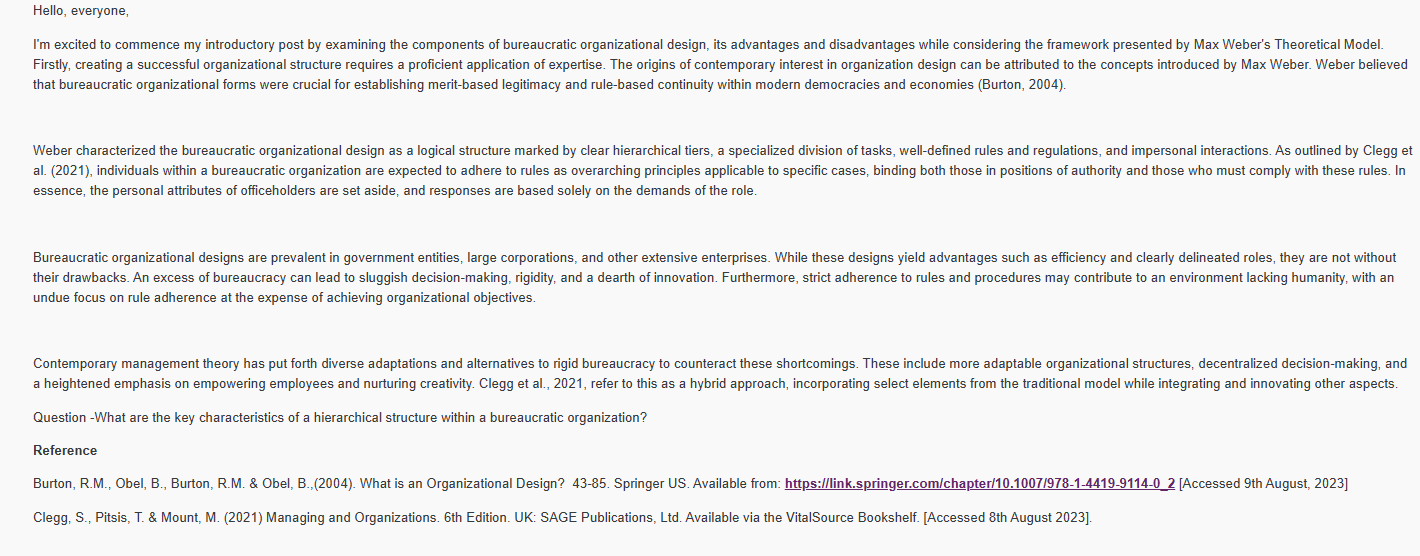Question
- I need to replay/ Respond for the following discussion below. - 200-300 words - Harvard System Reference - Support the replay with a References
- I need to replay/ Respond for the following discussion below.
- 200-300 words
- Harvard System Reference
- Support the replay with a References from your own and examples and experiences. ( 3 References)
- References to be within the UK
the discussion:
Hello, everyone,
I'm excited to commence my introductory post by examining the components of bureaucratic organizational design, its advantages and disadvantages while considering the framework presented by Max Weber's Theoretical Model. Firstly, creating a successful organizational structure requires a proficient application of expertise. The origins of contemporary interest in organization design can be attributed to the concepts introduced by Max Weber. Weber believed that bureaucratic organizational forms were crucial for establishing merit-based legitimacy and rule-based continuity within modern democracies and economies (Burton, 2004).
Weber characterized the bureaucratic organizational design as a logical structure marked by clear hierarchical tiers, a specialized division of tasks, well-defined rules and regulations, and impersonal interactions. As outlined by Clegg et al. (2021), individuals within a bureaucratic organization are expected to adhere to rules as overarching principles applicable to specific cases, binding both those in positions of authority and those who must comply with these rules. In essence, the personal attributes of officeholders are set aside, and responses are based solely on the demands of the role.
Bureaucratic organizational designs are prevalent in government entities, large corporations, and other extensive enterprises. While these designs yield advantages such as efficiency and clearly delineated roles, they are not without their drawbacks. An excess of bureaucracy can lead to sluggish decision-making, rigidity, and a dearth of innovation. Furthermore, strict adherence to rules and procedures may contribute to an environment lacking humanity, with an undue focus on rule adherence at the expense of achieving organizational objectives.
Contemporary management theory has put forth diverse adaptations and alternatives to rigid bureaucracy to counteract these shortcomings. These include more adaptable organizational structures, decentralized decision-making, and a heightened emphasis on empowering employees and nurturing creativity. Clegg et al., 2021, refer to this as a hybrid approach, incorporating select elements from the traditional model while integrating and innovating other aspects.
Question -What are the key characteristics of a hierarchical structure within a bureaucratic organization?
Reference
Burton, R.M., Obel, B., Burton, R.M. & Obel, B.,(2004). What is an Organizational Design? 43-85. Springer US. Available from: https://link.springer.com/chapter/10.1007/978-1-4419-9114-0_2 [Accessed 9th August, 2023]
Clegg, S., Pitsis, T. & Mount, M. (2021) Managing and Organizations. 6th Edition. UK: SAGE Publications, Ltd. Available via the
VitalSource Bookshelf. [Accessed 8th August 2023].

Step by Step Solution
There are 3 Steps involved in it
Step: 1

Get Instant Access to Expert-Tailored Solutions
See step-by-step solutions with expert insights and AI powered tools for academic success
Step: 2

Step: 3

Ace Your Homework with AI
Get the answers you need in no time with our AI-driven, step-by-step assistance
Get Started


